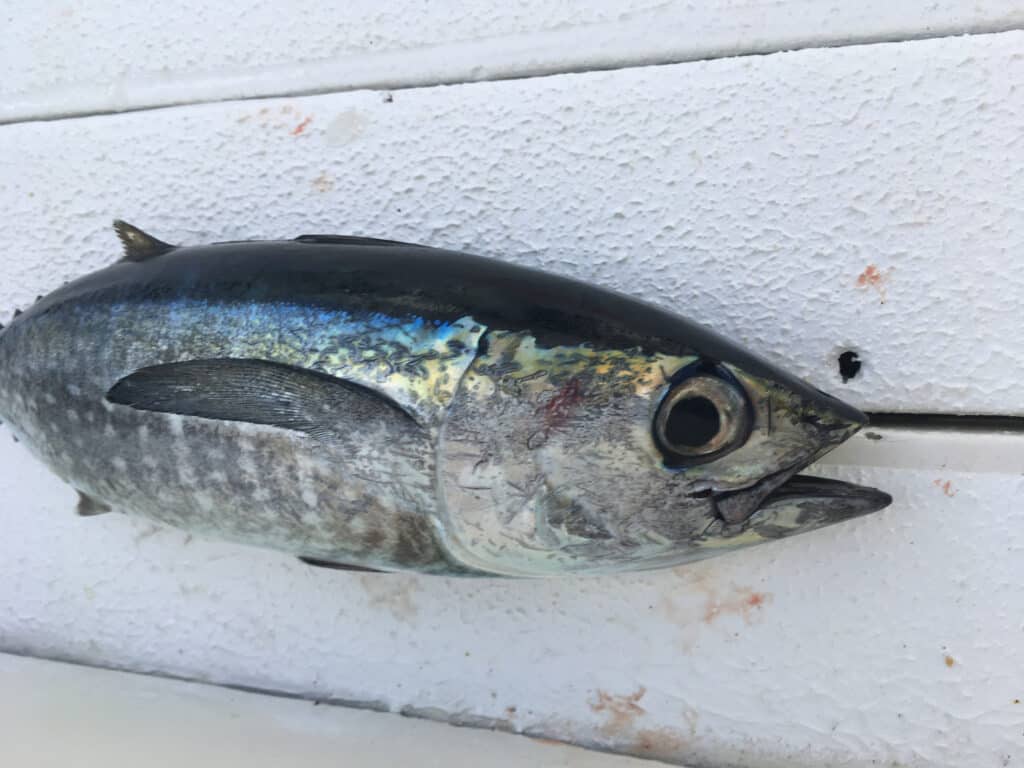Blackfin Tuna
Thunnus atlanticus
Blackfin tuna are the smallest species of tuna
Advertisement
Blackfin Tuna Scientific Classification
- Kingdom
- Animalia
- Phylum
- Chordata
- Class
- Actinopterygii
- Order
- Scombriformes
- Family
- Scombridae
- Genus
- Thunnus
- Scientific Name
- Thunnus atlanticus
Read our Complete Guide to Classification of Animals.
Blackfin Tuna Conservation Status
Blackfin Tuna Facts
- Prey
- plankton, crustaceans, flying fish
- Name Of Young
- fry
- Group Behavior
- School
- Fun Fact
- Blackfin tuna are the smallest species of tuna
- Biggest Threat
- Overfishing by humans
- Average Spawn Size
- up to 20 million eggs
- Habitat
- warm ocean waters
View all of the Blackfin Tuna images!
The blackfin tuna is the smallest tuna species of the Thunnus genus, growing up to an average of only 39 inches in length!
Blackfin Tuna Summary
The blackfin tuna is a tuna species that lives in the western Atlantic Ocean. It is one of the smaller species of tunas, reaching a maximum length of only 39 inches. It is dark blue to black on the back, with a silver-white belly. The blackfin tuna is an important commercial fish, and sports fishermen highly praise it. In addition, it constitutes the main ingredient for various recipes, including sushi and tuna nachos.
5 Incredible Blackfin Tuna Facts
- Blackfin tuna are one of the fastest fish in the ocean, capable of swimming at speeds up to 46 mph!
- They love warmer water. You can find them in waters warmer than 68 degrees Fahrenheit and closer to the surface.
- Blackfin tuna have one of the shortest lifespans of a tuna, living up to only 5 years of age.
- These fantastic fish are also precious commercially, with a single fish fetching a lot of money on the Japanese market.
- The blackfin tuna is an ecologically important species, serving as both predator and prey in the marine food web.
Blackfin Tuna Scientific Name
The scientific name for the blackfin tuna is Thunnus atlanticus. Thunnus is the Latin rendition of the Greek word thynnos, which means ‘tunny-fish’, whereas atlanticus is the Latin word for ‘Atlantic’, which refers to the Atlantic Ocean they live in. The blackfin tuna also goes by ‘Bermuda tuna’.
Blackfin Tuna Appearance
Blackfin tuna are dark blue to black on top and silver on the bottom. They have long, oval-shaped, slender bodies with forked tails. Their fins may appear black, as is their namesake. Blackfin tuna may not be as large as other tuna species, but they are by no means small fish. They can grow up to around 39 inches long and weigh approximately 46 pounds. In comparison, the Atlantic bluefin tuna can grow up to an incredible 13 feet long and weigh 2,000 pounds!

Blackfin tuna are typically silver on the bottom portion of their body and either dark blue or black on top.
©iStock.com/Paul Nickless
Blackfin Tuna Evolution
The blackfin tuna is an integral part of the ecosystem and has a long and exciting history. It is a member of the Scombridae family, which includes all tunas, mackerels, and bonitos. This family is believed to have originated in the Miocene epoch about 23 to 5 million years ago.
Blackfin Tuna Behavior
Blackfin tuna is a highly migratory species, meaning they travel long distances between different ocean areas to reproduce. In addition, they move around quite a bit in search of food and suitable habitat. Blackfin tuna are also very social creatures, often forming large schools with other blackfin tuna and other fish species.
Blackfin Tuna Habitat
Blackfin tuna live in tropical and subtropical waters in the western Atlantic Ocean, from the east coast of the United States to the east coast of Brazil. They prefer warmer waters (between 68-82 degrees Fahrenheit) because their body temperature needs to stay relatively warm to function correctly, but they can also tolerate cooler waters down to about 60 degrees Fahrenheit. Because of their preference for warm water, they often swim near the surface but can reach depths of up to 650 feet.
Blackfin Tuna Diet
As predators, tuna’s diet, in general, consists mainly of small fish, squid, and crustaceans.
Blackfin tuna’s diet can vary depending on location and time of year. For example, they may primarily eat small fish like sardines and anchovies in some areas, whereas, in other areas, they may mainly eat squid. Blackfin tuna hunt by swimming quickly after their prey and swallowing it whole. Due to this high activity level, they must consume a conspicuous amount of food daily.
What Does the Blackfin Tuna Eat?
The blackfin tuna can eat smaller fishes, invertebrates, and plankton. Larger blackfin tuna can even eat mackerels, eels, and flying fish.
What Eats the Blackfin Tuna?
The blackfin tuna’s most significant threats are larger fish, humans, marine animals, and sea birds.
Blackfin Tuna Predators and Threats
Blackfin tuna have to beware of many predatory animals.
For example, some of the most common predators of the blackfin tuna include sharks, dolphins, billfish, swordfish, marlins, and mackerels. While these predators can be dangerous to the tuna, they are also an essential part of the ecosystem. Without them, the tuna population would quickly become overpopulated, which could lead to problems in the ecosystem.
However, of the blackfin tuna’s many predators, humans are the most significant threat to the species. In fact, blackfin tuna is a highly sought-after fish and is used in cooking due to its delicious flavor and firm texture. Humans harvest blackfin tuna for their meat, oil, and fins.
Overall, the predation pressure on the blackfin tuna is high. This is particularly true for juveniles, which are unable to protect themselves from a wide range of predators. However, adults are also at risk from human exploitation and other threats.

Human fishnets are the major predatory threat for blackfin tuna.
©OlegRi/Shutterstock.com
Blackfin Tuna Reproduction
The blackfin tuna reproduces by spawning in oceanic water. Spawning is the process in which both the eggs and sperm are deposited and released into the ocean, where the breeding occurs outside of the parents’ body.
This fish has a high reproductive rate, with a female able to produce up to 20 million eggs in a single spawning season. The spawning season for blackfin tuna lasts approximately from May to October, with peak spawning occurring in June and July.
Blackfin Tuna Babies
After fertilization, the eggs float freely in the water column and hatch after about 24-48 hours. The larvae (also called fry) are very small (about 2 mm long) when they first hatch and grow quickly. Larvae drift with ocean currents before eventually settling into juvenile habitats. The fry grows speedily and reaches maturity in about two years. The fry is more susceptible to predators due to its smaller size.
Blackfin Tuna Lifespan
Blackfin tuna is a fast-growing, short-lived tuna species. While some tuna can live decades, blackfin tuna, as one of the smallest tuna species, “get old” at 5 years of age. After reaching sexual maturity at 2 years of age, blackfin tuna will feed and swim for another 2 to 3 years before dying.
Blackfin Tuna Population
Although no recent estimates are available, the population of the blackfin tuna seems healthy and stable despite being fished constantly. This is due mainly to their high reproductive rate. However, marine biologists have observed a slight population decline as trawling and net fishing ramps up in the Atlantic. In fact, one of the main reasons for blackfin tuna’s population decline is overfishing. This occurs when fishermen catch too many fish, and the fish need more time to reproduce and replenish their numbers.
Blackfin Tuna in Cooking
Blackfin tuna may not be as famous as other tuna species for consumption, but it is still a popular catch, particularly in Florida and the Bahamas. This fish is sushi-grade and can be eaten raw. In the Florida Keys, freshly-caught blackfin tuna is the main ingredient for a favorite local recipe called tuna nachos. Blackfin tuna can also be grilled and fried, and the meat tastes delicious!

Homemade tuna nachos: a favorite recipe in the Florida Keys!
©Dodong PatDU/Shutterstock.com
Similar Animals
View all 282 animals that start with BBlackfin Tuna FAQs (Frequently Asked Questions)
Are blackfin tuna carnivores, herbivores, or omnivores?
The blackfin tuna is a carnivore as it eats other animals, such as small fish, squid, and crustaceans.
Are the blackfin tuna monogamous?
The blackfin tuna is not considered monogamous as it lays eggs that will be fertilized in the water through a process called spawning.
Where is the blackfin tuna found?
The blackfin tuna is mainly found in the western Atlantic Ocean.
What is the average lifespan of a blackfin tuna?
Blackfin tunas generally live up to 5 years of age.
Thank you for reading! Have some feedback for us? Contact the AZ Animals editorial team.
Sources
- Facts and Details / Accessed January 29, 2023
- Fishbase / Accessed January 29, 2023















